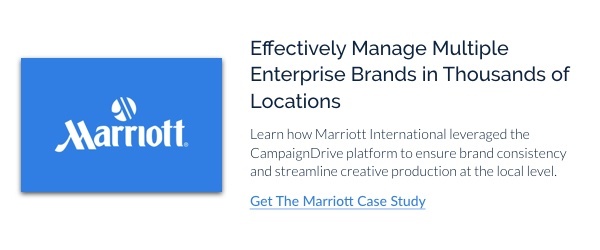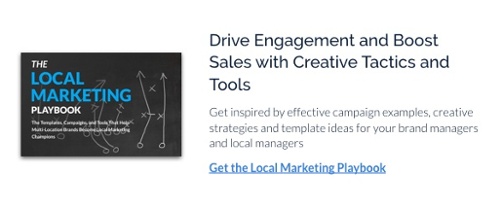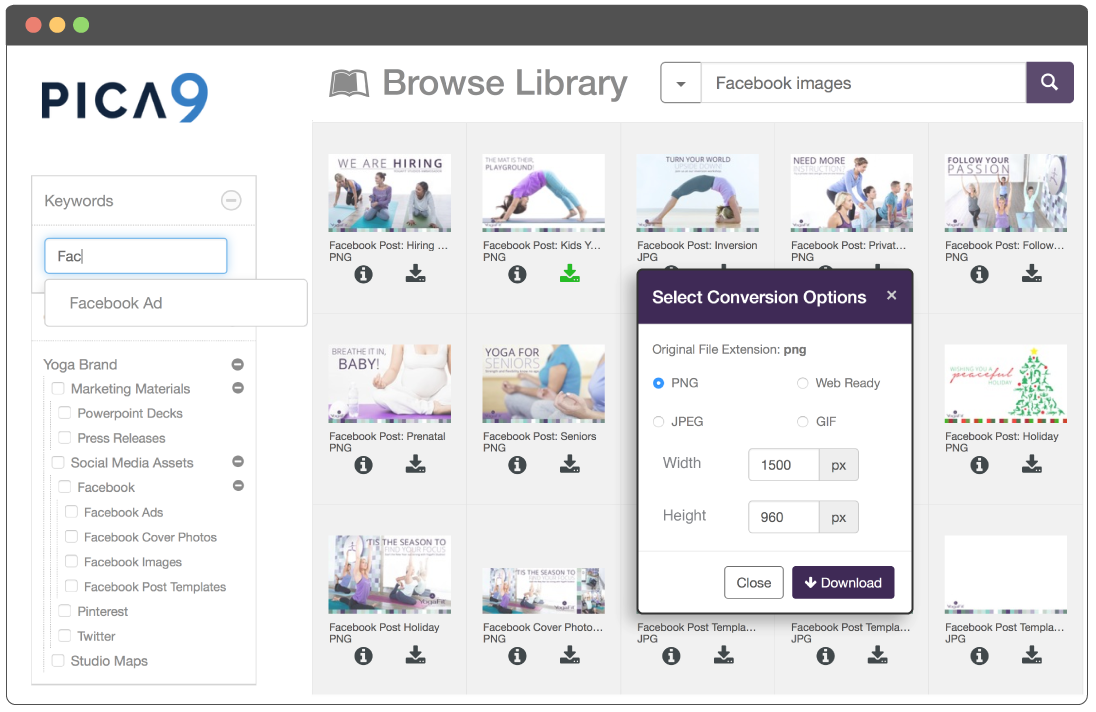How much are your organization’s intangible assets worth?
Your digital assets, employee knowledge, and data could be worth far more than traditional, hard assets like buildings, vehicles, and equipment, even if your fixed assets are worth more than the GDP of a small country.
For instance, when RadioShack went bankrupt, Vipal Mongan noted in the WSJ that their liquidation failed to include estimations of their “most valuable” assets of databases and brand. While the average brand today spends 14 percent of their budget building these assets (according to the same WSJ article), the value they return often far exceeds the number of dollars invested.
Digital assets are defined as anything that exists in digital form and contains most of its value in digital form, or is most easily accessed digitally. These assets create value for the company, even though they may seem like simple saved files. At a distributed organization, digital assets created for local or national marketing campaigns are unique, provide a differentiated advantage, and have the potential to contribute to your company’s value by driving sales.
Clearly, digital assets are highly valuable. How do you make sure that you don't lose the value of those assets and end up with a problem like RadioShack?
Having the right system in place, and shifting your mindset from “storing” your digital assets to “managing” them is key to realizing the maximum value your marketing collateral has to offer. Many companies relay on Digital Asset Management to accomplish this.
What is Digital Asset Management (DAM), and who can benefit from DAM software? Read on to learn more about DAM, and its use cases.
Use Cases: 7 Types of Digital Assets with Serious Value
Brand and marketing managers often confuse digital assets with marketing collateral. While your email templates and billboard advertising materials are certainly digital assets, they’re not the only digital materials your organization needs to store, ingest, modify, and retrieve.
Use cases for digital asset management are not limited to marketing. Virtually every function in your organization has assets that require careful management. We’ve outlined some of the most common organization-wide use cases below:
1. Finance
Financial statements and spreadsheets used for financial analysis and projection have value in the present. You may be required to retain past financial statements for a certain number of years to comply with regulatory requirements.
2. HR Manuals
Your training documents, including organization-wide onboarding guides and position-specific overviews, have value as tools for organizational knowledge management.
3. Key Branding Elements
Your company logo is one example of a key branding element which may exist in multiple digital forms. With the right methods of managing your digital assets, you gain access to subtle changes in your logo over the years, which could potentially be picked up and put to use today.
4. Photos and Graphics
Your organization’s photos and custom graphics from prior marketing campaigns still have value and potential for use, if they are cataloged and stored in a way that supports future access.
5. Historical Archives
Past information about your organization could have sentimental value. It could also have real financial value if you’re able to spin a decades-old photo of your founders into a national print advertising campaign for your anniversary.
6. Design Files
Working materials that designers and other creation-oriented employees produce become the basis for your marketing collateral or local marketing templates.
7. Operational Documents
Data on people, processes, and other operational data, can serve as a basis for research and process enhancement within the organization
Basically, if you can put something in Dropbox or Google Drive, it can be considered a digital asset. These may take many forms, including Spreadsheets, image files, Adobe Creative files, PDFs, audio files, video files, and more.
But if you find yourself hesitating to just put something in a file storing system like Google Drive because, "it could get lost;" it’s got value. Value requires your organization to look beyond the idea of “saving” documents to actively managing them. You need to continue getting value out of those assets long after they've been added to the file storage system.
The Difference Between “Saving Assets” and “Digital Asset Management”
You’ve got loads of options for saving your assets. You could use any method from a file folder on your desktop to commercial-grade file sharing solutions. However, the management component of Digital Asset Management comes down to the organization of assets, not just their storage.
If you simply store the assets (on an FTP site, on a network drive, on Google Drive), their usability and their security are both at risk. Additionally, it’s harder to find them and actually use them for what they’re intended.
Storing the assets is better than deleting them, but it doesn’t protect the value of an asset. With valuable digital assets, you need proper organization. Digital asset management is about protecting the existing value of your digital assets, and the potential to create new value from existing assets over time.
Who Benefits from DAM Software?
Can you manage your digital assets without a Digital Asset Management tool?
Sure.
Is it easy?
Definitely not.
DAM tools offer key advantages to organizations in any industry, and primarily consist of the ability to begin storing, discovering, using, and securing documents as soon as the technology is implemented. Even if your organization is using a file-sharing system already, it can be difficult to emulate the capabilities of a DAM tool using homegrown solutions - especially considering how affordable it’s become to use cloud or software-as-a-service (SaaS) options.
DAM tools allow organizations with terabytes of data - hundreds of thousands of photos - to immediately begin storing their assets and continue scaling upwards. There are discoverability advantages because DAM is built around metadata, which makes the assets easy to find. Some DAM systems are even using AI tools to identify metadata about assets that would normally take people tons of time, like telling if a photo is about a happy or sad emotional scene.
Finally, DAM tools can be integrated with your marketing technology stack for execution. Some DAMs, like CampaignDrive, are designed for distributed use cases, and allow local marketers to modify assets within the system.
The Advantages of DAM
DAM software can offer your organization an immediate advantage when it comes to size, speed, discoverability, security and scale. True DAM is also an end-to-end technology, which allows your organization to gain value from your assets at every stage in a way that fits your business model.
It should offer some features around the following ten core DAM characteristics:
- Ingest
- Secure
- Store
- Render & transform
- Enrich
- Relate
- Process
- Find
- Preview
- Produce and Publish
These features aid key team members, and expedite time-consuming tasks. Photographers benefit from the ingestion stage, as they can upload hundreds of gigabytes at a time - all in one bulk process. For designers, render and transform enables faster upload time, as you simply upload one version of each file and the DAM transforms it into different formats. Finally, the find feature helps brand managers find files quickly. While you may not remember the specific title, you can find files based on keywords and descriptions rather than a very precise label.
To learn more, we recommend How to Get the Most From Your Digital Asset Management
Which DAM is Best for My Brand?
Today’s DAM technologies are increasingly cloud or SaaS-based, allowing for flexibility, cost-savings, and speed. In Gartner’s Market Guide for Digital Asset Management, DAM options are categorized along a spectrum, which ranges from purely on-premises deployments to purely software-as-a-service options. However, the report acknowledged the trend towards lighter-weight options, with all of the DAM vendors they surveyed operating at least somewhat in the cloud.
Increasingly, DAM tools are SaaS based. See how this helps local marketing efforts.
However, selecting the right DAM isn’t as easy as matching your organization up with an existing DAM tool.
You may decide to select one or more standalone, integrated, or distributed DAM tools to fit your needs. For organizations that are heavily focused on meeting the needs of a massive local marketer network, a distributed DAM can offer the advantages of sensitive user permissions, smart content templates, and the right balance of control and permissions for local affiliates.
For other brands who do local marketing, a single DAM tool may not be enough. For instance, a distributed financial institution, in the wealth management industry, may use a standalone DAM integrated with a distributed DAM. The standalone DAM would help internal designers coordinate with extensive approval and compliance requirements, while the distributed DAM would provide access to local branch representatives once assets have been approved and processed in the other system.







